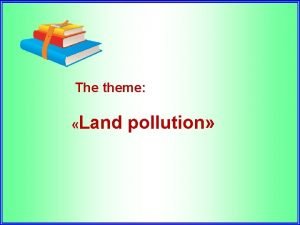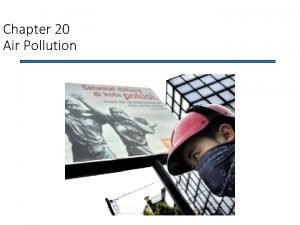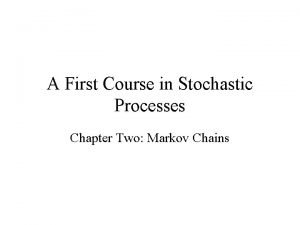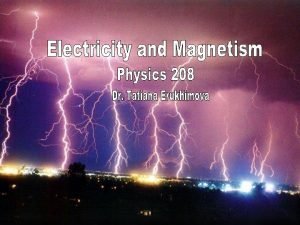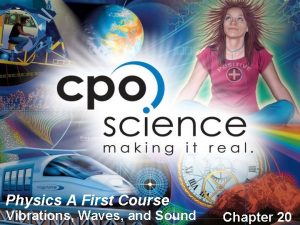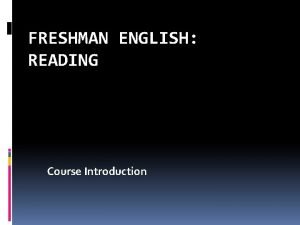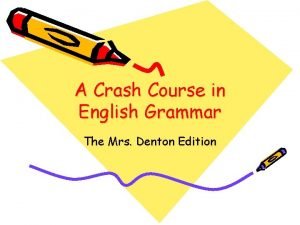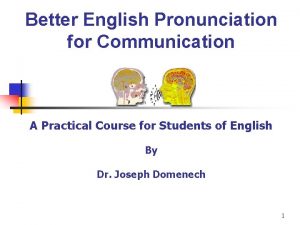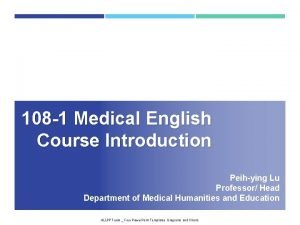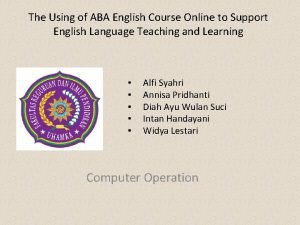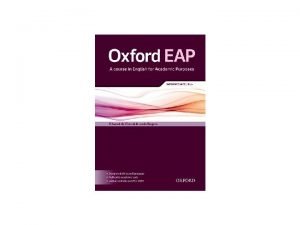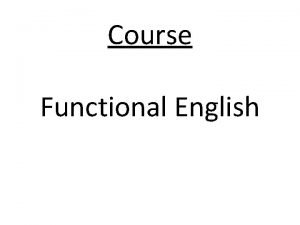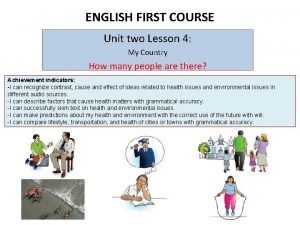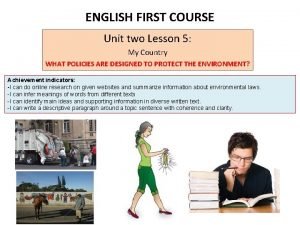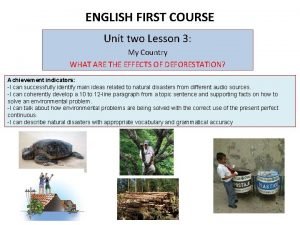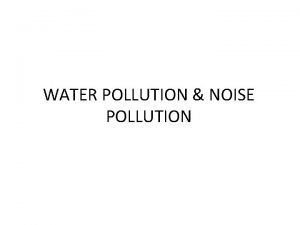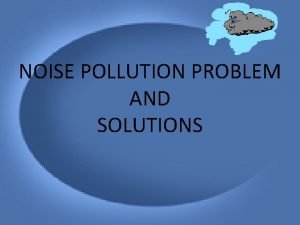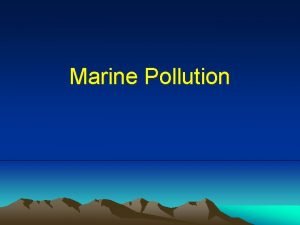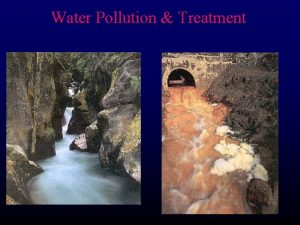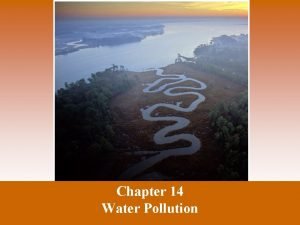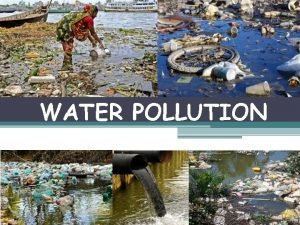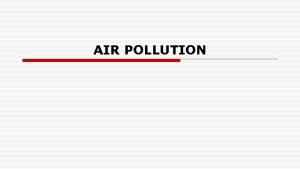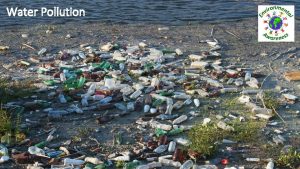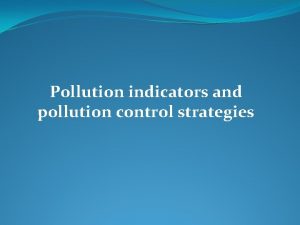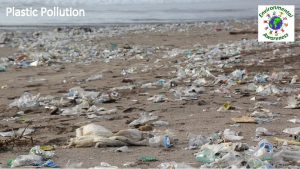ENGLISH FIRST COURSE Unit two Lesson 2 Pollution






















- Slides: 22

ENGLISH FIRST COURSE Unit two Lesson 2: Pollution and the Environment WHAT ARE THE MAJOR SOURCES OF POLLUTION? (P. 201) Achievement indicators: -I can successfully identify vocabulary related to pollution in different sources. -I can effectively scan papers and online articles for specific information on environmental issues. -I can write a 3 -paragraph composition, on protecting my health and environment with coherence and correct grammar structure. -I can respectfully express opinions about pollutions during group discussions.

Answer these questions at the end of the topic • What are different types of pollutants and their effects on the environment? • How much pollution is generated by humans? • What is the greenhouse effect? • What is water pollution, and how does it affect the people of El Salvador?

Agenda • • • • • Answer the questions at the end of topic Warm-up: pollution vocabulary and opposites Conversation Questions about conversation Vocabulary about pollution Vocabulary – definitions exercise Fill in the blanks exercise Reading about Green house effect Questionnaire about reading Conversation True-false exercise Questions- answers with your own information Words showing respect List of words showing respect Exercise about pollutants Passive Voice in present tense Verbs in past participle Passive Voice exercise II Passive Voice sentences exercise

Activity: Conversation: (P. 201) Listen to and read the conversation below. A: I can’t stand this situation! Every morning while I wait for the bus, I breathe in fumes from all of the passing vehicles. B: Tell me about it. I’ve been here for the past forty five minutes, and I feel like I have smoke in my lungs, Mary. A: I wish I could do something to change this problem. It would be nice if the city made laws on the amount of carbon dioxide that cars are allowed to emit. B: Yeah. That would be great. I think there are laws, but no one enforces them. A: Really? Wow! I didn’t know that, Jose. B: Look! Is that our bus coming? A: Yes, it is, with a cloud of black smoke following behind it. Man! B: Hold your breath and get on. It’s our only option! Glossary: -I can’t stand: commonly used to express that one is tired of a situation or circumstance. -Fumes: the gases that are released from an engine as a waste product. -Carbon dioxide: the most important greenhouse gas produced by humans. -Tell me about it: a common expression used when the receiver of the information has already experienced what the talker is referring to. -Emit: release or produce.

Activity 1: Answer the following questions about the conversation between Mary and Jose. (P. 201) 1. Why is Mary upset? 2. Is Jose okay with the problem? How do you know? 3. What should be the solution to the problem according to Mary? 4. Why is she surprised at Jose’s response to her solution? 5. Can you relate to this conversation? How?

Activity: vocabulary (P. 202) Pollution is the action of environmental contamination with manmade waste. Look at the list of pollutants caused by humans. ü smoke stacks: Smoke produced by industrial installations. ü oil spills: Accidents when big amounts of oil are spilled. They happen when drilling, piping or shipping oil. ü chemical waste: The waste of products made from harmful chemicals. ü raw sewage: Untreated waste materials. ü trash: Worthless or discarded material or objects. ü fertilizers: Product usually made from chemicals used to help plants grow and produce. ü landfills: A method of solid waste disposal in which trash is buried between layers of dirt.

Activity 2: Match the vocabulary words with the corresponding definitions. (P. 202) 1. An _____ is a plant or animal that is having trouble living in a certain place and all of them may die soon. 2. When you save trash that can be reused to create something new, you are ____. 3. A resource that is worth a lot is ____. 4. ____ is an increase in the average temperature of the earth’s atmosphere. 5. ____ is rain that has been made acidic by certain pollutants in the air. 6 Dangerous ____ are present in the air and water and may cause plants and animals to die. A. Recycling B. Valuable C. global warming D. endangered species E. acid rain F. chemicals

Activity 3: Fill in the blanks using the words in the box below. (P. 202) trash landfills fertilizers oil spills smoke raw sewage stacks transportation chemical waste 1. Mining in El Salvador would lead to the use of _____ that create smog and acid rain. 2. _____ pollution releases unhealthy gases such as carbon monoxide into the air. 3. _____is untreated sewage water that causes deadly bacteria and parasites. 4. After it rains, ____ flow into lakes and rivers causing chemical pollution in our water. 5. _____ occur from human mistakes and have a serious effect on marine life. 6. _____ is a waste that is made from harmful chemicals, normally from factories, that enter into our water streams. 7. _____ is a source of water pollution. It is very easy for trash to go into the drains and into our rivers and oceans. 8. _____ are the cheapest option for waste disposal but recycling is the best option.

Activity: (P. 203) Read the following explanation on what the greenhouse effect is. The greenhouse effect is the rise in temperature that the Earth experiences because certain gases in the atmosphere (water vapor, carbon dioxide, nitrous oxide, and methane) trap energy from the sun. Without these gases, heat would escape back into space and Earth would become a lot colder. Because of how they warm our world, these gases are referred to as greenhouse gases. Have you ever seen a greenhouse? Most greenhouses look like a small, glass house. Greenhouses are used to grow plants, especially in the winter. Greenhouses work by trapping heat from the sun. The glass panels of the greenhouse let in light but keep heat from escaping. This causes the greenhouse to heat up, much like the inside of a car parked in sunlight, and keeps the plants warm enough to live in the winter. The Earth’s atmosphere is all around us. It is the air that we breathe. Greenhouse gases in the atmosphere behave much like the glass panes in a greenhouse. Sunlight enters the Earth’s atmosphere, passing through the blanket of greenhouse gases. As it reaches the Earth’s surface, land, water, and biosphere absorb the sunlight’s energy. Once absorbed, this energy is sent back into the atmosphere. Some of the energy passes back into space, but much of it remains trapped in the atmosphere by the greenhouse gases, causing our world to heat up. The greenhouse effect is important. Without the greenhouse effect, the Earth would not be warm enough for humans to live. But if the greenhouse effect becomes stronger, it could make the Earth warmer than usual. Even a little extra warming may cause problems for humans, plants, and animals.

Activity 4: (in class)Answer the following questions by scanning the previous reading. (P. 203) 1. Write the definition of the greenhouse effect. 2. Where does the greenhouse effect get its name? 3. What are the names of the greenhouse gases that make up our atmosphere? 4. What would happen if all of the energy passed into space? 5. Where does the heat that enters the Earth’s atmosphere come from? 6. Who and what will be affected by the extra warming of the Earth?

Activity: Conversation Listen to and read the following short conversation. A member of a Non Governmental Organization (NGO) sat down at a meeting with the community leaders in La Papalota, Usulutan to begin discussing their drinking water. (P. 204) A: We finally have the results of the water test. B: Really! That was quick! How did it go? A: Your water is very contaminated, I am sorry to tell you. B: Oh no, what did you find? A: Well, we found high amounts of fertilizers and pesticides. B: What does that mean? Is it harmful? A: Yes, they are harmful. Fertilizers can create a lot of problems with infants and young children. It can cause them not to get enough oxygen through their bodies, and pesticides are also known for causing birth defects and liver problems. B: Could that be why we have so many children here with health problems? A: Definitely. But now that we know about this problem, we can begin a water treatment project. It is our goal to give you access to pure water for you and your children. B: Thank you so much. We are so grateful for your help. What’s the next step?

Activity 5: (in class)Decide whether the following statements are true or false according to the previous conversation. (P. 204) 1. The water from the test came back clean. 2. The water was high in minerals. 3. There were a lot of sick children in the community. 4. The people in the community were happy about the project. 5. The NGO found that the water was pure. 6. The NGO is worried that the water is harmful for livestock. 7. The community is in the last stage of developing a water project. 8. The people of the community drink pure water.

Activity 6: (in class)Answer the following questions with your own information. (P. 204) 1. What do you do with your household trash? 2. How do you conserve the water in your home? 3. Do you use sprays such as mosquito repellent? Do you think that sprays pollute the Earth? Why or why not? 4. Do you have the habit of turning off your lights in your home? If so, when and why? 5. Do you think it is important to protect the environment? Why? 6. Do you believe that your efforts can make a difference to better the environment?

Activity: Enrich your vocabulary (P. 205) Pretend that you are having a discussion about pollution with your neighbors. What are some key words that you would say to show them respect even though you do not agree with their opinions? The following phrases or questions may help you. 1. Yes, I can see your point, but I will have to disagree with you. 2. Could you please explain your position? 3. I agree with you, but I think that perhaps there is information missing. 4. You have a very good perspective, and I have enjoyed hearing what you have to say.

Activity 7: (in class)Identify and list the expressions of courtesy from the box below. ( P. 205) Excuse me. / Let me talk now. / Forget it. Please go on. /Be quiet. / I enjoyed our debate. That is a dumb opinion. /That’s a very good point. Let’s continue this conversation another day. / Shut up.

Activity 8: Place the pollutant in its appropriate category. Some words will fit in more than one box. (P. 205) trash fumes pesticides raw Monoxide smoke fertilizers chemical waste sewage landfills carbon oil spills • Water______________________________ • Air______________________________ • Soil______________________________

Language in Use: (in class)Passive voice in the present tense. (P. 206) • The passive voice focuses on the thing or person who receives the action of the verb. To use the passive voice in the present tense, use “be” + past participle of the verb. • Examples: Water is polluted by chemical waste. Children are affected by contaminated water. Contaminated water is drunk by people in the community. Trash is dumped in the rivers.

Activity 9: (in class)Write the past participle for the following verbs. (P. 206) 1. Exploit _______ 2. Produce ________ 3. Find ______ 4. Lose ______ 5. Pollute _____ 6. See _____ 7. Throw ____ 8. Treat _____ 9. Check _____ 10. Protect _____

Activity 10: Unscramble the words to make sentences in the passive voice. (P. 206) 1. streets/ thrown/ trash/ is/ in/ the 2. seen/ bottles/ at/ plastic/ are/ beach/ the 3. air/ lead/ air/ is/ contaminated/ found/ in 4. friendly/ countries/ in/ products/ environmentally/ made/ are/ industrial

Activity 11: Fill in the blanks to the following sentences with the correct tense of the verb in parenthesis. (P. 206) 1. Many people in El Salvador ___ trash in the streets. (throw) 2. Most of the trash in El Salvador is ___ in the cities. (produce) 3. The drainage system in the city is ___ with trash. (clog) 4. The most contaminated rivers are ___ in the city. (find) 5. San Salvador ___ tons of trash every day. (produce)

Activity 12: Change the following sentences to the passive voice. (P. 207) 1. People in the rural areas drink contaminated water. 2. Old buses pollute the air. 3. El Salvador uses the Lempa River to create energy. 4. Salvadoran people use a lot of plastic containers. 5. The Salvadoran Salvador government protects the El Impossible Park.

Activity 13: (in class) (P. 207) • Write five common ways that people in your community contribute to environmental problems. Write in complete sentences.
 Shall i compare thee to a summer's day annotation
Shall i compare thee to a summer's day annotation English bond t junction
English bond t junction Course number and title
Course number and title Chaine parallèle muscle
Chaine parallèle muscle Si vs english units
Si vs english units Right triangle trigonometry examples
Right triangle trigonometry examples About land pollution in english
About land pollution in english Unit 10, unit 10 review tests, unit 10 general test
Unit 10, unit 10 review tests, unit 10 general test Two sources of air pollution
Two sources of air pollution A first course in stochastic processes
A first course in stochastic processes A first course in atmospheric thermodynamics solutions
A first course in atmospheric thermodynamics solutions Physics a first course
Physics a first course English fresh man course
English fresh man course English grammar crash course
English grammar crash course Dentalized d
Dentalized d Nau igp
Nau igp Medical english online course
Medical english online course Aba english course
Aba english course Short authentic academic text
Short authentic academic text Functional english course outline
Functional english course outline English for specific purposes course design
English for specific purposes course design Unit supply's course test 2
Unit supply's course test 2 Unit supply's course test 2
Unit supply's course test 2






